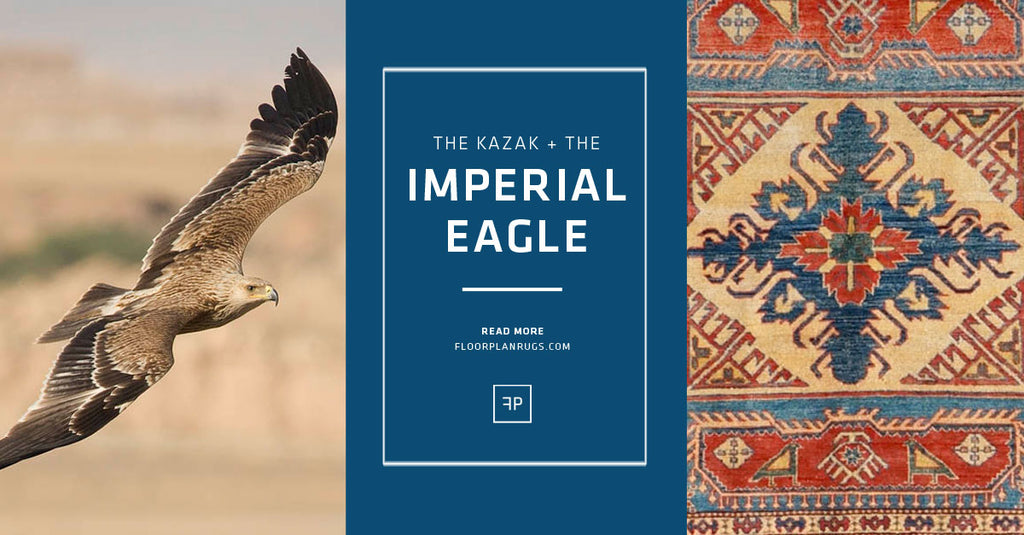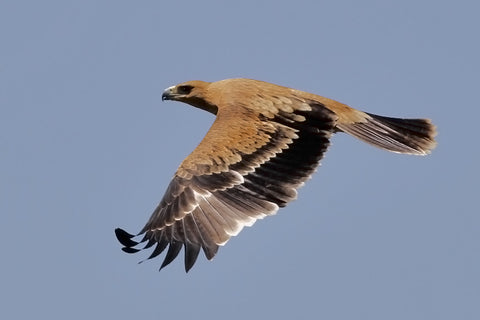- Continue Shopping
- Your Cart is Empty
The Kazak + The Imperial Eagle

KAZAK (pronounced: kah-zawk, like in the word ‘hawk’).The Kazak is one of the most beloved and recognizable rugs from the northern Caucasus region. Known for their deep reds, dark blues and creams, these geometric patterns reflect the life of the nomadic peoples who originally wove them.
Strife begets beauty
To talk about Kazaks, let’s back up, for a moment, and talk about….geography!
The Caucasus Region is that parcel of land flanked by the Black and Caspian Seas. It’s named for the Caucasus Mountain Range that marches through the region and is home to the modern states of Armenia, Georgia, Azerbaijan and a part of southwestern Russia.
For hundreds of years, this region has endured strife of nearly every variety: ethnic, religious, cultural. The balance of power has tipped back and forth many times, with dominance being wielded by both Islamic Tribes and Christian Armenians. This mashup of influences led to a distinct style, with influences from neighboring empires and regions — Persian and Ottoman Empires, and Turkoman tribes of Central Asia (think of the –stans).
This is where Caucasian rugs originated. There are many styles of Caucasian rugs, but because they share common design elements, I like to think of them as different dialects, rather than different languages. Kazak is one of these dialects.
The difference an H makes
Now, this leads to an interesting point, that comes down to the letter ‘h.’ In the rug industry, spelling is often fluid: words originating from other languages are translated into English phonetically, allowing a lot of room for interpretation. Normally, a stray ‘h’ wouldn’t mean much. But here, the difference between Kazak and Kazakh is pretty big.
Kazak refers to a type of rug design that originated in the Caucasus Region, in an area known as Kazak (between the towns of Tiflis and Erevan). Kazakh — with an H — refers to the people who dwell in the Central Asian country of Kazakhstan.
While these regions are often lumped together, and Turkoman (Kazakh) tribes did influence Kazak rugs, and they do both produce iconic tribal rugs, they are distinct, as are the rugs they make.
A reflection of lifestyle

Tribal rugs like Kazaks are known for their symbolism: motifs telegraph a story pastoral nomads, sheep and ram herders, keeping and hunting eagles, celebrating important ceremonies like motherhood and marriage, valuing characteristics of prosperity and faith. The Imperial Eagle shown above inspires an Eagle medallion that appears frequently in Kazaks, with many variations in the details.
More than other types of rugs, Kazak motifs are represented quite figuratively, a fact that reveals an important aspect of the culture here: they are more religiously diverse than some other weaving regions. Islam prohibits the depiction of life-like forms, which is one factor that influenced the abundance of floral motifs throughout Persian and Turkish carpets. Their content reveals a blended cultural, ethnic and religious heritage.
Kazak Hallmarks
The bold colors — an array of reds, blues and ivories — and the rectilinear motifs (where the angles of shapes are corners, not curves) are common in all Kazaks. Does that mean that all rugs with these elements are made in the Caucasus region? No, not anymore. Rugs with Kazak motifs, colors and symbols are produced in many weaving regions (Turkey, Pakistan, India) — “Kazak” now denotes a style rather than a hometown.
The Kazak Today
Although weaving traditions continue uninterrupted in some places, in many others, it has migrated or died off. This is the case of the Kazak. Changes in the economy, people and lifestyles in the Caucasus have contributed to a sharp decrease in weaving there; at this point, it’s a cottage industry, rather than a flourishing one. Ironically, and luckily, the shoe has jumped to the other foot: Central Asian Turkoman tribes that originally influenced Kazak rug weavers have now been influenced by the Kazak rugs, and have become some of the most accomplished craftsman producing Kazaks today.






Erin Eisinger
Author
Floorplan CEO and Co-Founder. Designer. Storyteller. Entrepreneur.